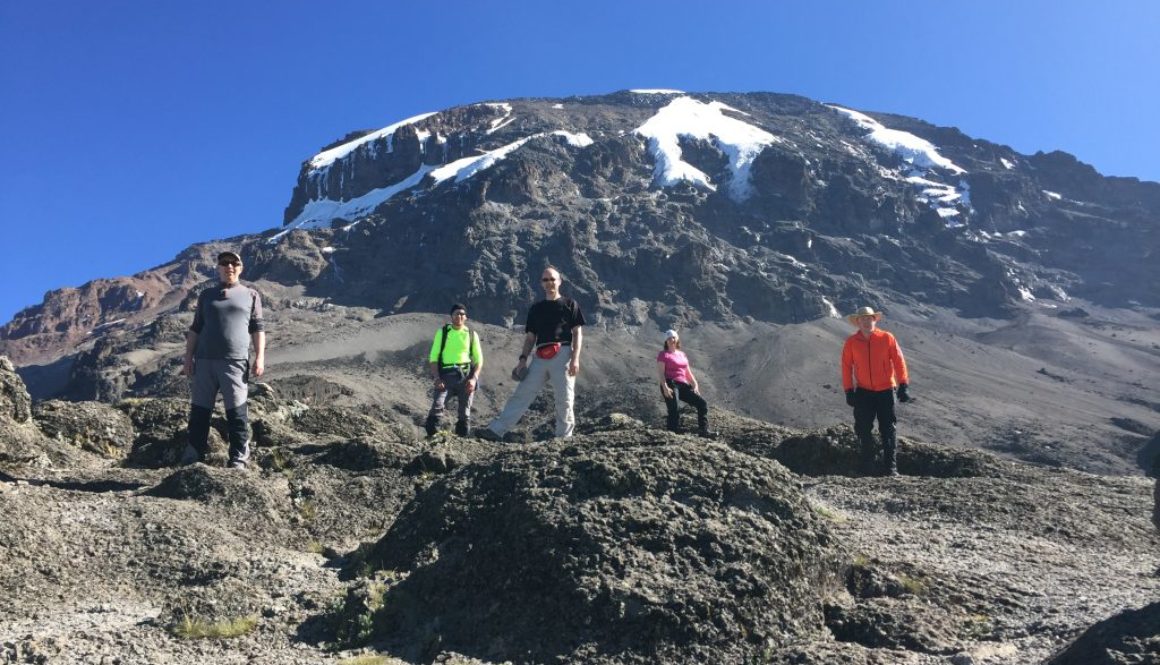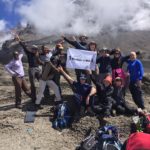What training do I need to climb Kilimanjaro?
Climbing Mount Kilimanjaro is classified as strenuous trek so you will need a good base level of fitness if you want to be successful in gaining the summit.
Terrain
The terrain on the ascent of Kilimanjaro is varied. On the lower slopes it’s easier trail, good underfoot and reasonably wide paths. It’s all too easy to set off too fast as you have the momentum and are raring to go. However, it’s crucial in order to acclimatise that you don’t over do it and take it very slowly. The guides have a number of tactics to inadvertently make you slow down! A favourite phrase you’ll hear alot is Pole Pole, which means slowly in Swahili.
It’s important that if you’re not familiar with walking on steep, rocky ground that you take a few walks in the UK mountains to familiarise yourself and to feel more confident. The higher you get, the paths become more rugged and technical. Mountains in Mind offers a Kilimanjaro training weekend where you can experience the delight of walking in the mountains and experience the kind of terrain that you can expect on an ascent of Kilimanjaro.
Back-to-back days
The ascent of Kilimanjaro is strenuous, there’s no getting away from that! Our standard trek takes 6 days to reach the summit and a further day for your descent. It is important that you are fit enough to be able walk over consecutive days for up to 5 or 6 hours each day. Although, you will be going slow on the climb, you will need to have built up your stamina to be able to keep going. The summit push day is particularly strenuous and combined with the altitude, lack of sleep and cold weather, you will need to dig deep with sheer grit and determination to get to the summit. You will be rewarded with magnificent views and the exertion will all be worth the effort when the endorphins kick in. You’ve earned bragging rights too!!
Weekends or even better, the longer bank holidays, you should aim to walk for two or three consecutive days on the trot. This will build up your strength and endurance. Your calf muscles will probably be screaming at you on the ascents if you’re unfamiliar with walking up hill. Conversely, on the descents your quads may quiver and your knees may ache. The more training you do, the more conditioned you’ll become and therefore you are increasing your chance of success. Although, you may wake up with stiff legs after undertaking a big walk, getting up and walking for a second day will often help to ease the stiffness and build up your stamina.
Ascent
We’ve mentioned training in the hills above. It is important that you can walk up hill relatively easily without becoming too breathless. As mentioned, you will be going very slowly and there will be plenty of opportunity to stop, take in the views and chatting to your fellow trekkers but as you climb higher it will become increasingly difficult with the lack of oxygen. You will need a certain level of fitness gained from walking up hills that will make it easier for you on the trek. You will also be carrying a day pack on your ascent, with your requirements for the day, such as, extra layers of clothing, food and drink so it’s important that you also familiarise yourself with carrying a small rucksack so that it feels comfortable.
Descent
Once you’ve reached the summit you’ll be so invigorated and elated that you’ll probably forget about the descent. Although, you’ll probably not be out of breath as much as on the ascent, it’s more heavier on your legs. There is also more of a tendency to slip on descents. Therefore, as well as training for your ascent it also important that you train and familiarise yourself with walking downhill so that you feel confident when descending. After all, what goes up…must come down!
Camping
The route that we take to the summit of Kilimanjaro does not have huts so you can expect to camp. If you have not slept under canvas before, please contact us and we can discuss the sleeping arrangements with you. It is important that you have a warm sleeping bag as it can be very cold at night and combined with the altitude this can leave you not able to sleep well. Being able to get a good nights rest is an important part of the recovery process to enable you to keep going the following day.
Eating
That’s right, you need to train to eat so you can familiarise yourself with what your body likes or dislikes whilst on the go! If you live in the UK you won’t have much opportunity to practice eating at altitude when your appetite becomes suppressed, however, on your day walks it’s worthwhile getting to know what you find digestible when moving as you’ll need to eat little and often on the climb. What one person finds good to eat is different for somebody else. I personally like to eat dried fruit, nuts and a little chocolate but nothing overly sweet.








